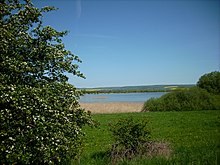Golden floodplain
The Goldene Aue (outdated Güldene Aue ) is a landscape between Nordhausen and Sangerhausen in the border area of Thuringia and Saxony-Anhalt ( Germany ).
location
The Goldene Aue extends between the southern edge of the Harz in the north and the Windleite and the Kyffhäuser in the south and is traversed by the Helme . Significant tributaries to the Helmets are the Zorge , Thyra , Leine and Gonna . To the south of Sangerhausen the landscape of the Diamantenen Aue joins. The flat meadows of the Helme, such as the Lange Rieth near Görsbach , alternate with hilly landscapes such as the Haardt (186 m) and the heath (at the Mittelkopf: 244 m) on its edges. In terms of nature, the Golden Aue is calculated as part of the Gera-Unstrut-Helme-Niederung within the Thuringian Basin (with edge plates) .
history
Originally only the area around the Aumühle between Görsbach and Auleben , in which the deserted village of Langenrieth is located, was called the Golden Aue . The term appeared for the first time in a document from the Walkenried monastery , which had started cultivation work in this area in 1144 and laid out a monastery courtyard Ow , later called Güldene Aue . The name of the landscape has been derived from this place name since the middle of the 13th century, when the desired influx of Flemish settlers made it possible to make most of the meadow landscape fertile. Of Martin Luther , the tradition assumes that the 1494 from the pilgrimage to Jerusalem returning Count Botho of Stolberg had announced: " He preferred to take his country called the Gilded Aue and wanted another leave the promised land ."
Today, the term Goldene Aue usually means not only the middle, but also the lower helmet. The predominantly agricultural area was at great risk of flooding until the 1960s due to the floods from the Harz rivers. Therefore, 1966 was completed as a countermeasure Kelbra Dam built, together with an upstream detention basin to flood protection guaranteed.
traffic
The Heerstrasse ran through the Goldene Aue from Nordhausen to Merseburg . Today it is used by the federal highway 80 , the federal highway 38 and the railway line Halle – Hann. Münden opened up. The A 71 Sangerhausen– Schweinfurt begins at the eastern edge .
Worth seeing
One of the sights of the Golden Aue is the small local history museum in Humboldt Castle in Auleben . Right next to it is the “Neuer Rüxleber Hof” museum. Heringen / Helme Castle , known for its medieval market , is only a few kilometers away . Herring is another specialty. Because the bell tower was destroyed twice in a row by the devastating fires, the bell was simply placed next to the church. The palace complexes in Roßla and Wallhausen are further east .
A tourist center has emerged around the Kelbra reservoir.
nature
Auleben is also known for the nearby gypsum karst landscape , with a very unique flora and fauna, which is worth protecting in this composition. At the time of the bird migration you can watch many birds at the nearby Kelbra reservoir, because the reservoir is a very suitable resting place. The following protected areas are located in the area of the Golden Aue:
- NSG Schloßberg-Solwiesen east of Auleben
- Bird sanctuary Helmestausee Berga-Kelbra in Saxony-Anhalt and that
- Bird sanctuary Kyffhäuser-Badraer Schweiz-Helmestausee in neighboring Thuringia
Many paths lead from the European village of Auleben over the ridge of the Windleite in the south to Sondershausen .
The soil consists mainly of brown earth , partly connected with Regosol and Pararendzina . It is very fertile with 80 to 100 arable fields .
Web links
- Golden Aue at NordhausenWiki
Individual evidence
- ↑ Map services of the Federal Agency for Nature Conservation ( information )
- ↑ E. Meynen , J. Schmithüsen : Handbook of the natural spatial structure of Germany. Federal Institute for Regional Studies, Remagen / Bad Godesberg 1953–1962 (9 deliveries in 8 books, updated map 1: 1,000,000 with main units 1960)
- ↑ Fritz Kirchner: Some new findings on the history of the Flemish settlements in the upper Golden Aue . In: Meyenburg Museum (ed.): Contributions to local history from the city and district of Nordhausen . Issue 13. Nordhausen 1988, p. 34-44 .
- ↑ https://www.thueringer-naturbrief.de/content/view/22/85/
Coordinates: 51 ° 26 ′ 42 " N , 11 ° 2 ′ 45" E

